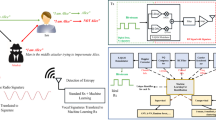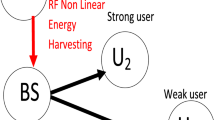Abstract
This paper investigates the channel selection problem for anti-jamming defense in an adversarial environment. In our work, we simultaneously consider malicious jamming and co-channel interference among users, and formulate this anti-jamming defense problem as a Stackelberg game with one leader and multiple followers. Specifically, the users and jammer independently and selfishly select their respective optimal strategies and obtain the optimal channels based on their own utilities. To derive the Stackelberg Equilibrium, a hierarchical learning framework is formulated, and a hierarchical learning algorithm (HLA) is proposed. In addition, the convergence performance of the proposed HLA algorithm is analyzed. Finally, we present simulation results to validate the effectiveness of the proposed algorithm.









Similar content being viewed by others
References
International Telecommunication Union (2015). Technical and operational principles for HF sky-wave communication stations to improve the man-made noise HF environment(ITU-R 258/5). ITU.
Zou, Y., Zhu, J., Wang, X., & Hanzo, L. (2016). A survey on wireless security: Technical challenges, recent advances, and future trends. Proceedings of the IEEE, 104(9), 1727–1765.
Sagduyu, Y. E., Berry, R. A., & Ephremides, A. (2011). Jamming games in wireless networks with incomplete information. IEEE Communications Magazine, 49(8), 112–118.
Chen, C., Song, M., Xin, C., & Backens, J. (2013). A game-theoretical anti-jamming scheme for cognitive radio networks. IEEE Network, 27(3), 22–27.
Zhang, L., Guan, Z., & Melodia, T. (2016). United against the enemy: anti-jamming based on cross-layer cooperation in wireless networks. IEEE Transactions on Wireless Communications, 15(8), 5733–5747.
Zhu, H., Fang, C., Liu, Y., et al. (2016). You can jam but you can’t hide: defending against jamming attacks for Geo-location database driven spectrum sharing. IEEE Journal on Selected Areas in Communications,. doi:10.1109/JSAC.2016.2605799.
Pietro, R. D., & Oligeri, G. (2013). Jamming mitigation in cognitive radio networks. IEEE Network, 27(3), 10–15.
Wu, Y., Wang, B., Liu, K., & Clancy, T. (2012). Anti-jamming games in multi-channel cognitive radio networks. IEEE Journal on Selected Areas in Communications, 30(1), 4–15.
Han, Z., Niyato, D., Saad, W., Basar, T., et al. (2012). Game theory in wireless and communication networks. Cambridge: Cambridge University Press.
Xu, Y., Wang, J., Wu, Q., et al. (2015). A game-theoretic perspective on self-organizing optimization for cognitive small cells. IEEE Communications Magazine, 53(7), 100–108.
Sun, Y., Wu, Q., Wang, J., Xu, Y., & Anpalagan, A. (2016). Veracity: Overlapping coalition formation based double auction for heterogeneous demand and spectrum reusability. IEEE Journal on Selected Areas in Communications, 34(10), 2690–2705.
Shao, H., Sun, Y., Zhao, H., et al. (2016). Locally cooperative traffic-offloading in multi-mode small cell networks via potential games. Transactions on Emerging Telecommunications Technologies, 27(7), 968–981.
Sun, Y., Wang, J., et al. (2016). Local altruistic coalition formation game for spectrum sharing and interference management in hyper-dense cloud-RANs. IET Communications, 10(15), 1914–1921.
Sharma, R. K., & Rawat, D. B. (2015). Advances on security threats and countermeasures for cognitive radio networks: A survey. IEEE Communications Surveys & Tutorials, 17(2), 1023–1043. (Second Quarter) .
Wang, B., Wu, Y., Liu, K., & Clancy, T. (2011). An anti-jamming stochastic game for cognitive radio networks. IEEE Journal on Selected Areas in Communications, 29(4), 877–889.
Li, H., & Han, Z. (2010). Dogfight in spectrum: Combating primary user emulation attacks in cognitive radio systems, part I: Known channel statistics. IEEE Transactions on Wireless Communications, 9(11), 3566–3577.
Oskoui, M. G., Khorramshahi, P., & Salehi, T. A. (2016). Using game theory to battle jammer in control channels of cognitive radio ad hoc networks. In Proceedings of the IEEE ICC (pp. 1–5).
El-Bardan, R., Brahma, S., & Varshney, P. K. (2016). Strategic power allocation with incomplete information in the presence of jammer. IEEE Transactions on Communications, 64(8), 3467–3479.
Song, T., Stark, W. E., Li, T., & Tugnait, J. K. (2016). Optimal multiband transmission under hostile jamming. IEEE Transactions on Communications, 64(9), 4013–4027.
Hanawal, M. K., Abdel-Rahman, M. J., & Krunz, M. (2014). Game theoretic anti-jamming dynamic frequency hopping and rate adaptation in wireless systems. In Proceedings of the WiOpt Conference (pp. 247–254).
Hanawal, M. K., Abdel-Rahman, M. J., & Krunz, M. (2016). Joint adaptation of frequency hopping and transmission rate for anti-jamming wireless systems. IEEE Transactions on Mobile Computing, 15(9), 2247–2259.
Abdel-Rahman, M. J., & Krunz, M. (2014). Game-theoretic quorum-based frequency hopping for anti-jamming rendezvous in DSA networks. In Proceedings of the IEEE DYSPAN (pp. 248–258).
Sun, Y., Wang, J., Sun, F., & Zhang, J. (2016). Energy-aware joint user scheduling and power control for two-tier femtocell networks: A hierarchical game approach. IEEE Systems Journal,. doi:10.1109/JSYST.2016.2580560.
Kang, X., Zhang, R., & Motani, M. (2012). Price-based resource allocation for spectrum-sharing femtocell networks: A Stackelberg game approach. IEEE Journal on Selected Areas in Communications, 30(3), 538–549.
Yang, D., Zhang, J., Fang, X., & Richa, A., et al. (2012). Optimal transmission power control in the presence of a smart jammer. In Proceedings of the IEEE Globecom (pp. 5506–5511).
Yang, D., Xue, G., Zhang, J., Richa, A., & Fang, X. (2013). Coping with a smart jammer in wireless networks: A stackelberg game approach. IEEE Transactions on Wireless Communications, 12(8), 4038–4047.
Xiao, L., Chen, T., Liu, J., & Dai, H. (2015). Anti-jamming transmission stackelberg game with observation errors. IEEE Communications Letters, 19(6), 949–952.
Jia, L., Yao, F., Sun, Y., et al. (2016). Bayesian Stackelberg game for anti-jamming with incomplete information. IEEE Communications Letters, 20(10), 1991–1994.
Tang, X., Ren, P., Wang, Y., et al. (2015). Securing wireless transmission against reactive jamming: A Stackelberg game framework. In Proceedings of the IEEE GLOBECOM (pp. 1–6).
Xiao, L., Xie, C., Chen, T., et al. (2016). Mobile offloading game against smart attacks. In Proceedings of the IEEE INFOCOM (pp. 403–408).
Xiao, L., Xie, C., Chen, T., et al. (2016). A mobile offloading game against smart attacks. IEEE Access, 4, 2281–2291.
Wu, Q., Xu, Y., Wang, J., et al. (2013). Distributed channel selection in time-varying radio environment: Interference mitigation game with uncoupled stochastic learning. IEEE Transactions on Vehicular Technology, 62(9), 4524–4538.
Zheng, J., Cai, Y., Yang, W., et al. (2013). A fully distributed algorithm for dynamic channel adaptation in canonical communication networks. IEEE Wireless Communications Letters, 2(5), 491–494.
Zheng, J., Cai, Y., Xu, Y., & Anpalagan, A. (2014). Distributed channel selection for interference mitigation in dynamic environment: A game theoretic stochastic learning solution. IEEE Transactions on Vehicular Technology, 63(9), 4757–4762.
Chen, X., Zhang, H., Chen, T., & Lasanen, M.: Improving energy efficiency in green femtocell networks: a hierarchical reinforcement learning framework. In Proceedings of the IEEE ICC 2013 (pp. 2241–2245).
Sun, Y., Shao, H., Liu, X., et al. (2015). Traffic offloading in two-tier multi-mode small cell networks over unlicensed bands: A hierarchical learning framework. KSII Transactions on Internet and Information Systems, 9(11), 4291–4310.
Monderer, D., & Shapley, L. S. (1996). Potential games. Games and Economic Behavior, 14(1), 124–143.
Sastry, P., Phansalkar, V., & Thathachar, M. (1994). Decentralized learning of Nash equilibria in multi-person stochastic games with incomplete information. IEEE Transactions on Systems, Man, and Cybernetics, 24(5), 769–777.
Zhong, W., Xu, Y., Tao, M., et al. (2010). Game theoretic multimode precoding strategy selection for MIMO multiple access channels. IEEE Signal Processing Letters, 17(6), 563–566.
Zheng, J., Cai, Y., Lu, N., et al. (2015). Stochastic game-theoretic spectrum access in distributed and dynamic environment. IEEE Transactions on Vehicular Technology, 64(10), 4807–4820.
Xu, Y., Wang, J., Wu, Q., et al. (2012). Opportunistic spectrum access in unknown dynamic environment: A game-theoretic stochastic learning solution. IEEE Transactions on Wireless Communications, 11(4), 1380–1391.
Xu, Y., Xu, Y., & Anpalagan, A. (2015). Database-assisted spectrum access in dynamic networks: A distributed learning solution. IEEE Access, 3, 1071–1078.
Watkins, C. J. C. H., & Dayan, P. (1992). Q-learning. Machine Learning, 8, 279–292.
Kianercy, A., & Galstyan, A. (2012). Dynamics of Boltzmann Q-learning in two-player two-action games. Physical Review E, 85(4), 1–10.
Acknowledgements
This work was supported in part by the Natural Science Foundation for Distinguished Young Scholars of Jiangsu Province under Grant BK20160034, in part by the National Science Foundation of China under Grant 61631020, Grant 61671473, Grant 61401508, and Grant 61401505, in part by Jiangsu Provincial Natural Science Foundation of China Grant BK20130069, and Grant BK20151450, and in part by the Open Research Foundation of Science and Technology in Communication Networks Laboratory.
Author information
Authors and Affiliations
Corresponding author
Rights and permissions
About this article
Cite this article
Yao, F., Jia, L., Sun, Y. et al. A hierarchical learning approach to anti-jamming channel selection strategies. Wireless Netw 25, 201–213 (2019). https://doi.org/10.1007/s11276-017-1551-9
Published:
Issue Date:
DOI: https://doi.org/10.1007/s11276-017-1551-9




